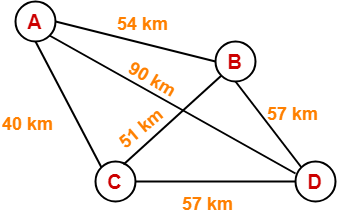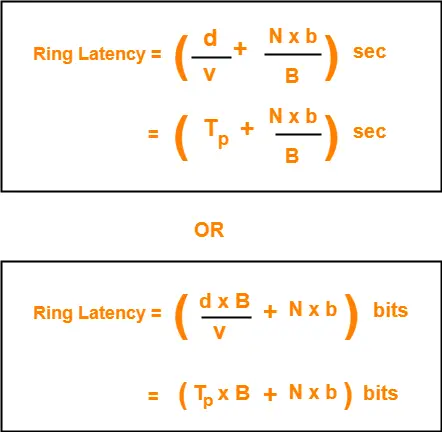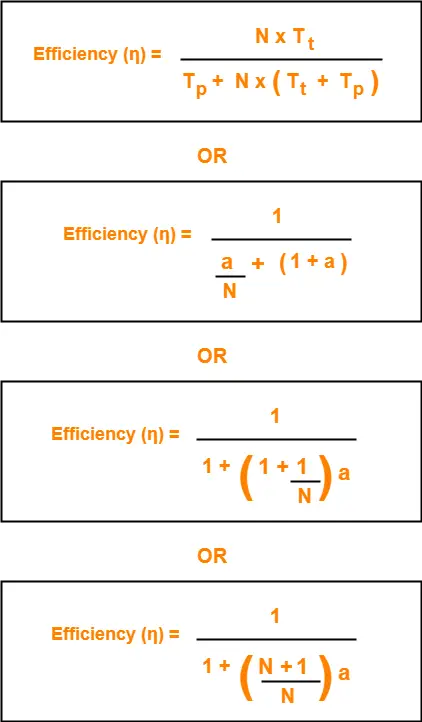CSMA / CD Protocol-
Before you go through this article, make sure that you have gone through the previous article on CSMA / CD Protocol.
We have discussed-
- CSMA / CD allows a station to transmit data if it senses the carrier free.
- After undergoing collision, station waits for random back off time before transmitting again.
- Back Off Algorithm is used to calculate back off time.
Also Read- Back Off Algorithm
In this article, we will discuss practice problems based on CSMA / CD and Back Off Algorithm.
PRACTICE PROBLEMS BASED ON CSMA / CD AND BACK OFF ALGORITHM-
Problem-01:
After the kth consecutive collision, each colliding station waits for a random time chosen from the interval-
- (0 to 2k) x RTT
- (0 to 2k-1) x RTT
- (0 to 2k-1) x Maximum Propagation delay
- (0 to 2k-1) x Maximum Propagation delay
Solution-
Clearly, Option (B) is correct.
Problem-02:
In a CSMA / CD network running at 1 Gbps over 1 km cable with no repeaters, the signal speed in the cable is 200000 km/sec. What is minimum frame size?
Solution-
Given-
- Bandwidth = 1 Gbps
- Distance = 1 km
- Speed = 200000 km/sec
Calculating Propagation Delay-
Propagation delay (Tp)
= Distance / Propagation speed
= 1 km / (200000 km/sec)
= 0.5 x 10-5 sec
= 5 x 10-6 sec
Calculating Minimum Frame Size-
Minimum frame size
= 2 x Propagation delay x Bandwidth
= 2 x 5 x 10-6 sec x 109 bits per sec
= 10000 bits
Problem-03:
A 2 km long broadcast LAN has 107 bps bandwidth and uses CSMA / CD. The signal travels along the wire at 2 x 108 m/sec. What is the minimum packet size that can be used on this network?
- 50 B
- 100 B
- 200 B
- None of the above
Solution-
Given-
- Distance = 2 km
- Bandwidth = 107 bps
- Speed = 2 x 108 m/sec
Calculating Propagation Delay-
Propagation delay (Tp)
= Distance / Propagation speed
= 2 km / (2 x 108 m/sec)
= 2 x 103 m / (2 x 108 m/sec)
= 10-5 sec
Calculating Minimum Frame Size-
Minimum frame size
= 2 x Propagation delay x Bandwidth
= 2 x 10-5 sec x 107 bits per sec
= 200 bits or 25 bytes
Thus, Option (D) is correct.
Problem-04:
A and B are the only two stations on Ethernet. Each has a steady queue of frames to send. Both A and B attempts to transmit a frame, collide and A wins first back off race. At the end of this successful transmission by A, both A and B attempt to transmit and collide. The probability that A wins the second back off race is ___ .
- 0.5
- 0.625
- 0.75
- 1.0
Solution-
According to question, we have-
1st Transmission Attempt-
- Both the stations A and B attempts to transmit a frame.
- A collision occurs.
- Back Off Algorithm runs.
- Station A wins and successfully transmits its 1st data packet.
2nd Transmission Attempt-
- Station A attempts to transmit its 2nd data packet.
- Station B attempts to retransmit its 1st data packet.
- A collision occurs.
Now,
- We have been asked the probability of station A to transmit its 2nd data packet successfully after 2nd collision.
- After the 2nd collision occurs, we have-
At Station A-
- 2nd data packet of station A undergoes collision for the 1st time.
- So, collision number for the 2nd data packet of station A = 1.
- Now, station A randomly chooses a number from the range [0,21-1] = [0,1].
- Then, station A waits for back off time and then attempts to retransmit its data packet.
At Station B-
- 1st data packet of station B undergoes collision for the 2nd time.
- So, collision number for the 1st data packet of station B = 2.
- Now, station B randomly chooses a number from the range [0,22-1] = [0,3].
- Then, station B waits for back off time and then attempts to retransmit its data packet.
Following 8 cases are possible-
| Station A | Station B | Remark |
| 0 | 0 | Collision |
| 0 | 1 | A wins |
| 0 | 2 | A wins |
| 0 | 3 | A wins |
| 1 | 0 | B wins |
| 1 | 1 | Collision |
| 1 | 2 | A wins |
| 1 | 3 | A wins |
From here,
- Probability of A winning the 2nd back off race = 5 / 8 = 0.625.
- Thus, Option (B) is correct.
Problem-05:
Suppose nodes A and B are on same 10 Mbps Ethernet segment and the propagation delay between two nodes is 225 bit times. Suppose A and B send frames at t=0, the frames collide then at what time, they finish transmitting a jam signal. Assume a 48 bit jam signal.
Solution-
Propagation delay (Tp)
= 225 bit times
= 225 bit / 10 Mbps
= 22.5 x 10-6 sec
= 22.5 μsec
At t = 0,
- Nodes A and B start transmitting their frame.
- Since both the stations start simultaneously, so collision occurs at the mid way.
- Time after which collision occurs = Half of propagation delay.
- So, time after which collision occurs = 22.5 μsec / 2 = 11.25 μsec.

At t = 11.25 μsec,
- After collision occurs at t = 11.25 μsec, collided signals start travelling back.
- Collided signals reach the respective nodes after time = Half of propagation delay
- Collided signals reach the respective nodes after time = 22.5 μsec / 2 = 11.25 μsec.
- Thus, at t = 22.5 μsec, collided signals reach the respective nodes.
At t = 22.5 μsec,
- As soon as nodes discover the collision, they immediately release the jam signal.
- Time taken to finish transmitting the jam signal = 48 bit time = 48 bits/ 10 Mbps = 4.8 μsec.
Thus,
Time at which the jam signal is completely transmitted
= 22.5 μsec + 4.8 μsec
= 27.3 μsec or 273 bit times
Problem-06:
Suppose nodes A and B are attached to opposite ends of the cable with propagation delay of 12.5 ms. Both nodes attempt to transmit at t=0. Frames collide and after first collision, A draws k=0 and B draws k=1 in the exponential back off protocol. Ignore the jam signal. At what time (in seconds), is A’s packet completely delivered at B if bandwidth of the link is 10 Mbps and packet size is 1000 bits.
Solution-
Given-
- Propagation delay = 12.5 ms
- Bandwidth = 10 Mbps
- Packet size = 1000 bits
Time At Which Collision Occurs-
Collision occurs at the mid way after time
= Half of Propagation delay
= 12.5 ms / 2
= 6.25 ms
Thus, collision occurs at time t = 6.25 ms.
Time At Which Collision is Discovered-
Collision is discovered in the time it takes the collided signals to reach the nodes
= Half of Propagation delay
= 12.5 ms / 2
= 6.25 ms
Thus, collision is discovered at time t = 6.25 ms + 6.25 ms = 12.5 ms.
Scene After Collision-
After the collision is discovered,
- Both the nodes wait for some random back off time.
- A chooses k=0 and then waits for back off time = 0 x 25 ms = 0 ms.
- B chooses k=1 and then waits for back off time = 1 x 25 ms = 25 ms.
- From here, A begins retransmission immediately while B waits for 25 ms.
Waiting Time For A-
- After winning the back off race, node A gets the authority to retransmit immediately.
- But node A does not retransmit immediately.
- It waits for the channel to clear from the last bit aborted by it on discovering the collision.
- Time taken by the last bit to get off the channel = Propagation delay = 12.5 ms.
- So, node A waits for time = 12.5 ms and then starts the retransmission.
- Thus, node A starts the retransmission at time t = 12.5 ms + 12.5 ms = 25 ms.
Time Taken in Delivering Packet To Node B-
Time taken to deliver the packet to node B
= Transmission delay + Propagation delay
= (1000 bits / 10 Mbps) + 12.5 ms
= 100 μs + 12.5 ms
= 0.1 ms + 12.5 ms
= 12.6 ms
Thus, At time t = 25 ms + 12.6 ms = 37.6 ms, the packet is delivered to node B.
Problem-07:
The network consists of 4 hosts distributed as shown below-

Assume this network uses CSMA / CD and signal travels with a speed of 3 x 105 km/sec. If sender sends at 1 Mbps, what could be the minimum size of the packet?
- 600 bits
- 400 bits
- 6000 bits
- 1500 bits
Solution-
- CSMA / CD is a Access Control Method.
- It is used to provide the access to stations to a broadcast link.
- In the given network, all the links are point to point.
- So, there is actually no need of implementing CSMA / CD.
- Stations can transmit whenever they want to transmit.
|
In CSMA / CD, The condition to detect collision is- Packet size >= 2 x (distance / speed) x Bandwidth |
To solve the question,
- We assume that a packet of same length has to be used in the entire network.
- To get the minimum length of the packet, what distance we should choose?
- To get the minimum length of the packet, we should choose the minimum distance.
- But, then collision would be detected only in the links having distance less than or equal to that minimum distance.
- For the links, having distance greater than the minimum distance, collision would not be detected.
- So, we choose the maximum distance so that collision can be detected in all the links of the network.
So, we use the values-
- Distance = 90 km
- Speed = 3 x 105 km/sec
- Bandwidth = 1 Mbps
Substituting these values, we get-
Minimum size of data packet
= 2 x (90 km / 3 x 105 km per sec) x 1 Mbps
= 2 x 30 x 10-5 sec x 106 bits per sec
= 600 bits
Thus, Option (A) is correct.
Next Article- Token Passing | Access Control Method
Get more notes and other study material of Computer Networks.
Watch video lectures by visiting our YouTube channel LearnVidFun.

























